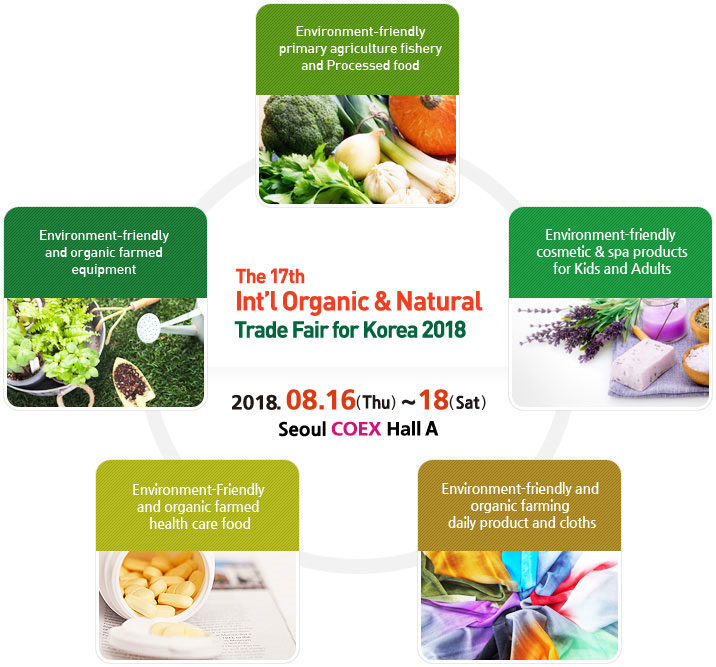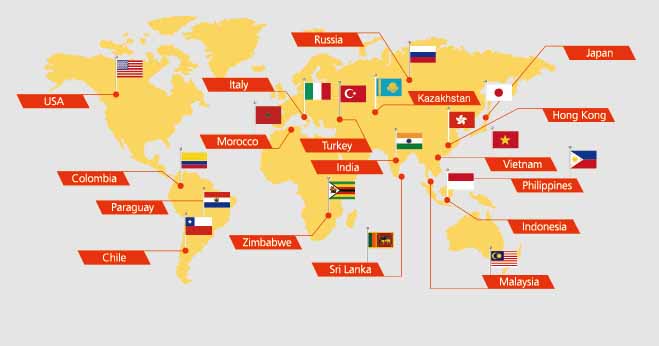The 17th Int’l Organic & Natural Trade Fair 2018, Seul, Korea, from 16th of August to 18th.
There is fast-growing interest in Environmental-Friendly agriculture and organic farming due to public concerns about westernized eating habits and environmental pollution.
Also, the change of perspective leads to food, processed food, and cosmetic industries to further development.
The 17th Int’l Organic & Natural Trade Fair 2018 will provide opportunities to understand about latest organic farming trends. Through this show Domestic Organic product will be acknowledged once more as well as domestic agriculture and Farming industries are competitive in World Market.
Exhibitor’s Profile
Organic farming
Organic Products
Domestic Exhibitor’s: 349 booths. 256 companies
International Exhibitor’s:26 companies, 18 countries

Visitors:
36 976
Visitors Profile

Organizer
Smart Sales Reviews
Korea Organic Facts
- The total market size for organic packaged food and beverages in South Korea in 2017 is US$225.8mn, making it the 16th largest market in the world by value.
- Per capita spending on organic packaged food and beverages in South Korea is US$4.43, which ranks as the 26th largest spending per capita in the world.
- The largest company by sales in organic packaged food and beverages is Maeil Dairies Co Ltd, which maintains 53.4% of total sales. Maeil Dairies is followed by National Agricultural Cooperative Federation and Seoul Dairy Cooperative.
- Organic packaged food and beverages in South Korea will see slow year-on-year growth of close to 2% in 2018. This is much slower than the rest of the Asia Pacific region, which will experience approximately 13% year-on-year growth in 2018.
Market Trends
- South Korean parents’ demand for safe healthy products for their children is a main driver of organic packaged food and beverage sales growth.
- The overall premiumization trend in the market is also fueling sales growth.
- Among organic packaged food categories, baby food, dairy and rice are some of the most popular, as parents increasingly want the highest-quality food for their children
- Organic beverages are uncommon in South Korea, and sales consist mainly of organic 100% juice and green tea.
General Health & Wellness Trends
- Consumers’ health consciousness and the country’s aging population are driving sales of health and wellness products, which have grown in recent years.
- Consumers are becoming more interested in products’ ingredients, and manufacturers’ marketing strategies have changed to provide as much ingredient information as possible on product packaging.
- The sales value of health and wellness products is projected to continue to grow in the near term, albeit at a slower rate than in recent years.
Economy:
- South Korea’s economy is growing at a moderate pace, driven mainly by a significant increase in public spending and modest gains in private final consumption.
- South Korea’s potential growth rate is around 3%.
- Annual rates of real GDP growth will gradually fall to around 2.0% by 2025.
Population demographics:
- South Korea’s population is growing slowly and totaled 51.0 million in 2017.
- The most important population shift is occurring in those over 65 years of age, a group that represented 14.0% of the total population in 2017 and will increase to 24.3% of the population by 2030.
- As South Korea’s population ages, its labor force contracts, which may pose economic challenges in coming years.
Income & expenditure:
- Disposable income per capita in South Korea amounted to US$15,306 in 2017, and real gains of 2.1% are forecast for 2018.
- Communications will see the strongest category spending in the 2018-2030 period, followed by health goods and medical services.
- South Korea’s economy is growing at a moderate pace, driven mainly by a significant increase in public spending and modest gains in private final consumption.
- South Korea’s potential growth rate is around 3%.
- Annual rates of real GDP growth will gradually fall to around 2.0% by 2025.
Population
Economy:
- South Korea’s economy is growing at a moderate pace, driven mainly by a significant increase in public spending and modest gains in private final consumption.
- South Korea’s potential growth rate is around 3%.
- Annual rates of real GDP growth will gradually fall to around 2.0% by 2025.
Population demographics:
- South Korea’s population is growing slowly and totaled 51.0 million in 2017.
- The most important population shift is occurring in those over 65 years of age, a group that represented 14.0% of the total population in 2017 and will increase to 24.3% of the population by 2030.
- As South Korea’s population ages, its labor force contracts, which may pose economic challenges in coming years.
Income & expenditure:
- Disposable income per capita in South Korea amounted to US$15,306 in 2017, and real gains of 2.1% are forecast for 2018.
- Communications will see the strongest category spending in the 2018-2030 period, followed by health goods and medical services.
:
- South Korea’s population is growing slowly and totaled 51.0 million in 2017.
- The most important population shift is occurring in those over 65 years of age, a group that represented 14.0% of the total population in 2017 and will increase to 24.3% of the population by 2030.
- As South Korea’s population ages, its labor force contracts, which may pose economic challenges in coming years.
Income & expenditure:
- Disposable income per capita in South Korea amounted to US$15,306 in 2017, and real gains of 2.1% are forecast for 2018.
- Communications will see the strongest category spending in the 2018-2030 period, followed by health goods and medical services.
August, 2018 -Smart Sales.

